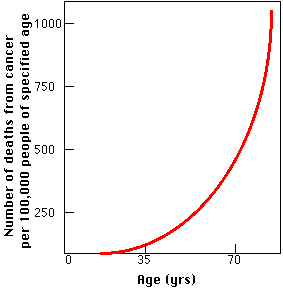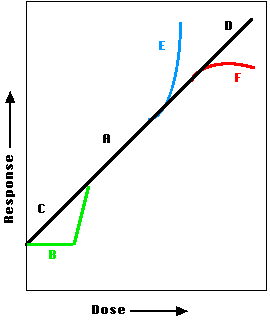Cancer
What is it?
A cancer is an uncontrolled proliferation of cells.
- In some the rate is fast; in others, slow; but in all cancers the cells never stop dividing.
- This distinguishes cancers - malign tumors or malignancies - from benign growths like moles where their cells eventually stop dividing.
- Cancers are clones. No matter how many trillions of cells are present in the cancer, they are all descended from a single ancestral cell.
- Cancers begin as a primary tumor. At some point, however, cells break away from the primary tumor and - traveling in blood and lymph - establish metastases in other locations of the body. Metastasis is what usually kills the patient.
- Cancer cells are usually less differentiated than the cells of the tissue where they arose. Many people feel that this reflects a process of dedifferentiation, but I doubt it. Rather, cancers arise in precursor cells of the tissue; cells that are normally in a period of rapid mitosis and not yet fully differentiated.
Cancer cells contain several mutated genes. The mutations are found in genes that are involved in mitosis; that is, in genes that control the cell cycle.
These genes are proto-oncogenes and/or tumor suppressor genes.
.gif)
What probably happen is:
- A single cell in a tissue suffers a mutation (red line) in a gene involved in the cell cycle.
- This results in giving that cell a slight growth advantage over other cells in the tissue.
- As that cell develops into a clone, some if its descendants suffer a second mutation (red line) to a proto-oncogene or tumor-suppressor gene.
- This further deregulates the cell cycle of that cell and its descendants.
- As the rate of mitosis in that clone increases, the chances of further DNA damage increases.
- Eventually, so many (perhaps six or eight) mutations have occurred that the growth of that clone becomes completely unregulated.
- The result: full-blown cancer.

Colon Cancer: An Example
Colon cancer:
- Begins with the development of polyps in the epithelium of the colon.
Polyps are benign growths
- As time passes, the polyps may get bigger.
- At some point, nests of malignant cells may appear within the polyps
- If the polyp is not removed, some of these malignant cells will escape from the primary tumor and metastasize throughout the body.
Examination of the cells at the earliest, polyp, stage, reveals that they contain one or two mutations associated with cancer. Frequently these include- the deletion of a tumor suppressor gene on chromosome 5
- a mutant proto-oncogene (often RAS).
The cells in the later stages of the disease show additional types of damage such as deletions of p53 and another tumor-suppressor gene.
Note that each of the mutations shown probably occurs in one cell of the type affected. This cell then develops into the next stage of the progression. The mutations do not necessarily occur in the order shown, although they often do.
Cancers become more common as one gets older.
The graph shows the death rate from cancer in the United States as a function of age. The graph can best be explained by the need for an accumulation of several "hits" to genes that control the cell cycle before a cell can become cancerous.

The graph also explains why cancer has become such a common cause of death during the twentieth century. It probably has very little to do with exposure to the chemicals of modern living and everything to do with the increased longevity that has been such a remarkable feature of this century.
A population whose members increasingly survive accidents and infectious disease is a population increasingly condemned to death from such "organic" diseases as cancer.
Causes of Cancer
Cancers are caused by
- anything that damages DNA; that is anything that is mutagenic
- radiation that can penetrate to the nucleus and interact with DNA
- chemicals that can penetrate to the nucleus and damage DNA. Chemicals that cause cancer are called carcinogens.
- anything that stimulates the rate of mitosis. This is because a cell is most susceptible to mutations when it is replicating its DNA during the S phase of the cell cycle.
- certain hormones (e.g., hormones that stimulate mitosis in tissues like the breast and the prostate gland)
- agents that cause inflammation (which generates DNA-damaging oxidizing agents in the cell)
- certain other chemicals; some the products of technology
- certain viruses
Many viruses have been studied that reliably cause cancer when laboratory animals are infected with them. What about humans?
The evidence obviously is indirect but some likely culprits are:
- two papilloma viruses that infect the reproductive organs
- the hepatitis B and hepatitis C viruses, which infect the liver and are closely associated with liver cancer (probably because of the chronic inflammation they produce)
- some herpes viruses such as the Epstein-Barr virus (implicated in Burkitt's lymphoma) and KSHV that is associated with Kaposi's sarcoma (a malignancy frequently seen in the late stages of AIDS)
- two human T-cell leukemia viruses, HTLV-1 and HTLV-2
But note! Clearly something else must contribute to the development of cancer following infection by these agents.
- Many people are infected by these viruses and do not develop cancer.
- When cancers do arise in infected people, they still follow our rule of clonality. Many cells have been infected, but only one (usually) develops into a tumor.
So it appears that only if an infected cell is unlucky enough to suffer one or more other types of damage will it develop into a tumor.
Is there a safe dose of any mutagen or carcinogen?
 We live surrounded by radiation and by chemicals that
We live surrounded by radiation and by chemicals that
- cause mutations in test organisms (like bacteria and yeast)
- cause an increase in the rate of cancers in experimental animals (rats and mice)
Is there any safe dose for humans of these agents (which include oxygen!)
The question is exceedingly difficult to answer and, I believe, at low doses, unanswerable. Why?
This graph shows several theoretical dose-response relationships.
There is considerable evidence that at moderate doses of a mutagen or carcinogen, the response is linear (A). However, at very low doses of some chemicals, there may be a threshold (B) below which the agent has no effect. For other chemicals, and probably for radiation, it is likely that even the tiniest doses will have an effect (C), but the population exposed must be large enough to observe it. Note that even at zero dose, the line does not intercept the origin. This is because even unexposed animals (including people) show a spontaneous level of response (e.g., tumors).
At very high doses, the rate of response may increase faster than the dose (E) as, for example, the probability of a single cell suffering two mutations increases. On the other hand, very high doses may kill off damaged cells before they can develop into tumors (F).
High doses of radiation cause cancer. Various studies, including excellent ones on the survivors of Hiroshima and Nagasaki, show that a population exposed to a dose of 12,500 mrem will have a measurable increase (about 1%) in the incidence of cancer. Note that the measurements are made on a population, not on individuals. We can never say that a particular individual exposed to a particular dose of radiation will develop cancer. The induction of cancer is a chance ("stochastic") event unlike the induction of radiation sickness which is completely predictable. The element of chance arises because cancer is an event that occurs in a single cell unlucky enough to suffer damage to two or more specific genes.
However, the energy needed to cause mutations is very low. So if you expose a sufficiently large number of cells to even tiny doses of radiation, some cell is going to be unlucky. How can we evaluate the risk?
- 12,500 mrem causes a 1% increase in cancer in a population; i.e.,
- it should cause an increase of 1 cancer in every 100 people in the exposed population.
- But if our reasoning is correct, a population of 100,000 people exposed to 12.5 mrem should also yield one case of radiation-induced cancer.
- In any population, where the product of radiation dose times population size equals 1.25 x 106, one case of cancer will be induced.
- The product of exposure multiplied by the size of the exposed population is known as the collective dose. Its units are (person)x(mrem).
An example:
- The population of the U.S. in 1990 was about 250 million.
- so anything that increases the annual exposure of the U.S. population by as little as 1 mrem per year would cause an additional 200 cases of cancer.
(250 x 106 persons)(1 mrem)
_____________________________ = 200 cancers
1.25 x 106 person mrem/cancer
But consider:
- the current death rate in the U.S. is about 0.0088; that is,
- 2.2 million people die each year (250 x 106 x 0.0088)
- 23-24% of these deaths are caused by cancer, so
- the number of cancer deaths each year exceeds 500,000
- How can we possible detect an increase of 200 faced with these large numbers?
- It has been estimated (in this case, using a collective dose value of 5 x 106 person mrem/cancer) that the radioactive fallout from the nuclear accident at Chernobyl (now often spelled "Chornobyl") in 1986 will cause an increase of 17,000 cancers over the lifetime of people living in the Northern Hemisphere.
- Large those this estimate seems, it is dwarfed by the 513 million cancer deaths that will occur anyway in this population.
- This is why I say above that the answer to the question of the dangers of low doses of radiation is unknowable.
Chemicals and cancer: dioxin
At one time it was found that the chemical dioxin, which can be produced as a contaminant in the manufacture of paper and cardboard, was leaching from milk cartons into milk itself.
- the concentration in the milk averaged 0.1 part per trillion (ppt) or 0.0001 µg in a liter (109 µg) of milk. Assuming:
- 0.1 µg per day given to rats increases their rate of tumors by 1%
- the idea of collective dose applies to chemicals (that is, a single molecule in an unlucky cell can turn it cancerous)
- people are 100 times more sensitive to dioxin than rats (probably not true) and
- people are 100 times larger than rats
- we conclude that there is a risk of 10 additional cancers in every million people consuming a liter (about a quart) of milk a day from cardboard containers.
And, in fact, this was the estimate made.
The uncertainties in such assumptions helps explain the controversy that has so often swirled around the test data on such chemicals as
Some chemicals appear to have a safety threshold
Cells have a number of different methods for detoxifying certain types of chemicals. So long as these mechanisms are not overwhelmed, they should provide a threshold of safety.
An example: dioxin
- Dioxin binds to a cytoplasmic receptor protein (like the steroid hormone receptors)
- only when the concentration of dioxin reaches a level high enough to fill all the binding sites on the receptor does the receptor move into the nucleus and damage DNA
26 April 1999
.gif)


 We live surrounded by radiation and by chemicals that
We live surrounded by radiation and by chemicals that